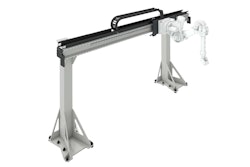
“Higher speeds are always better.”
I hear that often from manufacturing enterprises. However, it isn’t true. Let’s break down some common misconceptions about network speed and look at tips for accurately measuring needs.
Misconception #1: I Always Need the Max Speed
The way we manage operations today is different than ever before. We have automated assembly lines, real-time inventory tracking, devices that help manage fleets and monitor remote systems, and others that create digital twins of products and monitor warehouses and manufacturing plants for environmental changes.
These devices and tools demand higher networking speeds than if we were simply using our network to check email. However, even they don’t require the highest speeds available. Let me explain.
Our WiFi standards today offer especially high speeds. WiFi 5 gives the possibility of 1.3 Gbps, and WiFi 6/6E jumps up to 9.6 Gbps. The argument I usually hear is that if those speeds are available, they must be necessary for superior performance.
However, what we all have to remember is that those are maximum theoretical speeds. They aren’t intended to be used for daily tasks. Most devices and applications aren’t even capable of reaching those speeds.
Then what’s the point? Why did the standards evolve to offer those speeds?
They are largely there to be shared. WiFi is a shared medium, wherein each device accesses the airwaves to transfer its data, and then jumps off to allow others to take a turn. If each device can share faster, it makes room for other devices sooner. This is also why WiFi 6 was designed to allow multiple devices to communicate simultaneously on the airwaves. Less waiting in line means faster communication.
No device needs anywhere close to 9.6 Gbps on its own. That was never the design principle behind optimal performance. But that much speed shared amongst 50 or 100 devices? That does make a difference.
Misconception #2: High Latency Means I Need to Update Speed
Speed is a measurement of what is possible on your network, and latency is how fast data is actually transmitted. You want latency to be as low as possible. If it’s high, this is a sign of a problem. It doesn’t mean the issue is automatically with your speed though.
Latency can be high because of any number of issues. Common problems include:
- Network congestion.
- Outdated infrastructure.
- Problems with servers.
- An insufficient number of access points (APs) (the distance data packets have to travel plays a role in latency).
- Building construction or layout (some materials slow down data packets, such as concrete walls or metal shelving).
Companies need complete visibility into network behavior in order to accurately identify root causes of issues. Only then can the correct resolution be applied.
Misconception #3: I Can Always Settle for the Lowest Speed
You always need your network to support the best speed for each device and application. This changes from instance to instance, and is why network optimization is impossible without continuous, device-level insights.
Faster speeds also support better cybersecurity. As we know, warehouses and plants rely on digital technologies to operate seamlessly. Their networks are also home to vast amounts of stored, private customer information. Ensuring cybersecurity is essential. That can include measures such as firewalls and intrusion detection. It also means that when network vulnerabilities and device bugs are identified, IT needs to be able to push out updates as quickly as possible.
For this reason, you want your network to support higher speeds, so that a slow-down still keeps you at peak performance, rather than dropping you into behavior-issue territory.
Speed isn’t about extremes - low or high - it’s about knowing your specific network and use cases and what is needed for all duties and responsibilities.
Your network’s needs are unique. Determining the speed you need requires you to know the speed requirements for every device and application, and the numbers of each on your network. You need to select a speed that will support utilization at peak times.
How do you know your peak times and numbers of devices and applications? With complete network visibility.
There are a number of tools and solutions available that will provide this data. I recommend looking for one that gives continuous analytics (as in, truly non-stop), and will automatically provide insights, not only capture data. A solution that takes thousands of hours of data capture and translates it into usable, actionable insights helps IT teams respond faster to network needs.
You need real-time performance data, as well as insights into long-term performance trends. You need to know the speed capabilities of every device and application, and current bandwidth usage, latency, and packet loss. You need to be able to see how performance has changed over time, and predict what that means for the future. You need to know the root causes of all issues.
Your speed needs will change - as devices connect and disconnect, as your company grows, as you add or remove certain devices. Keep abreast of your network’s unique speed requirements with continuous analytics. This will help you plan budget-friendly, effective upgrades suitable for your network’s performance.






















